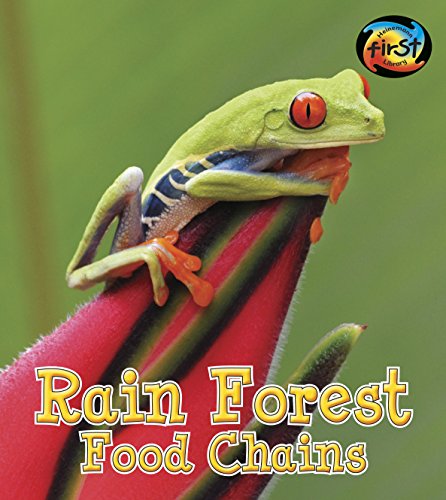-
Coral Reef Food Chains
Bobbie Kalman, Kelley MacAulay
Paperback (Crabtree Publishing Company, March 15, 2005)Intended for ages 5-9, this book takes readers on an exciting underwater journey to one of the world's most fascinating habitats. Stunning photographs and detailed illustrations help show: the relationships between the plants, herbivores, carnivores, and omnivores that live in and around the reef; the dangers to these fragile habitats; why coral reefs are described as the rainforests of the sea. T
T
-
Ocean Food Chains
Angela Royston
Paperback (Heinemann, July 1, 2014)This book explores the food chains and webs that exist in an ocean habitat. It equips readers with crucial vocabulary, using examples from that habitat to explain the roles of producers, consumers and decomposers, and illustrates how living things depend upon each other. Readers learn how fragile food chains can be, how they can be broken, and what we can do to prevent this. M
M
-
River Food Chains
Angela Royston
Paperback (Heinemann, July 1, 2014)This book explores the food chains and webs that exist in river habitats. It equips readers with crucial vocabulary, using examples from that habitat to explain the roles of producers, consumers and decomposers, and illustrates how living things depend upon each other. Readers learn how fragile food chains can be, how they can be broken, and what we can do to prevent this. L
L
-
Rain Forest Food Chains
Angela Royston
Paperback (Heinemann, July 1, 2014)This book explores the rich food chains and webs that exist in a rain forest habitat. It equips readers with crucial vocabulary, using examples from that habitat to explain the roles of producers, consumers and decomposers, and illustrates how living things depend upon each other. Readers learn how fragile food chains can be, how they can be broken, and what we can do to prevent this. M
M
-
Desert Food Chains
Angela Royston
Paperback (Heinemann, July 1, 2014)This book explores the food chains and webs that exist in a desert habitat. It equips readers with crucial vocabulary, using examples from that habitat to explain the roles of producers, consumers and decomposers, and illustrates how living things depend upon each other. Readers learn how fragile food chains can be, how they can be broken, and what we can do to prevent this. L
L
-
Grassland Food Chains
Angela Royston
Paperback (Heinemann, July 1, 2014)This book explores the food chains and webs that exist in a grassland habitat. It equips readers with crucial vocabulary, using examples from that habitat to explain the roles of producers, consumers and decomposers, and illustrates how living things depend upon each other. Readers learn how fragile food chains can be, how they can be broken, and what we can do to prevent this. J
J
-
Mountain Food Chains
Angela Royston
Paperback (Heinemann, July 1, 2014)This book explores the food chains and webs that exist in a mountain habitat. It equips readers with crucial vocabulary, using examples from that habitat to explain the roles of producers, consumers and decomposers, and illustrates how living things depend upon each other. Readers learn how fragile food chains can be, how they can be broken, and what we can do to prevent this. M
M
-
Desert Food Chains
Katie Kawa
Paperback (Powerkids Pr, Jan. 1, 2015)Which animals and plants can survive in a dry desert environment? Readers learn about the living things that make up desert food chains, including cacti, snakes, and scorpions. Colorful photographs of desert life make readers feel like theyre exploring new parts of this habitat with each turn of the page. Fact boxes provide additional information about the creatures that make up desert food chains, and a detailed food web shows how these food chains all come together. The desert is an extreme habitat, and readers will enjoy learning about the extreme plants and animals that live there. M
M
-
Rain Forest Food Chains
Angela Royston
Library Binding (Heinemann, July 1, 2014)This book explores the rich food chains and webs that exist in a rain forest habitat. It equips readers with crucial vocabulary, using examples from that habitat to explain the roles of producers, consumers and decomposers, and illustrates how living things depend upon each other. Readers learn how fragile food chains can be, how they can be broken, and what we can do to prevent this. M
M
-
Mountain Food Chains
Angela Royston
Library Binding (Heinemann, July 1, 2014)This book explores the food chains and webs that exist in a mountain habitat. It equips readers with crucial vocabulary, using examples from that habitat to explain the roles of producers, consumers and decomposers, and illustrates how living things depend upon each other. Readers learn how fragile food chains can be, how they can be broken, and what we can do to prevent this. M
M
-
Backyard Food Chains
Katie Kawa
Hardcover (PowerKids Press, Jan. 1, 2015)Every backyard is its own habitat for many different living things. Readers learn how these living things are connected as they pass energy to one another. Plants, insects, mammals, and other creatures are linked through backyard food chains, and, as readers will see, these food chains come together to form a large backyard food web. A helpful food web diagram is presented alongside engaging text and fact boxes. Readers see even the tiniest backyard critters up close through colorful, detailed photographs. M
M
-
Ocean Food Chains
Angela Royston
Library Binding (Heinemann, July 1, 2014)This book explores the food chains and webs that exist in an ocean habitat. It equips readers with crucial vocabulary, using examples from that habitat to explain the roles of producers, consumers and decomposers, and illustrates how living things depend upon each other. Readers learn how fragile food chains can be, how they can be broken, and what we can do to prevent this. M
M